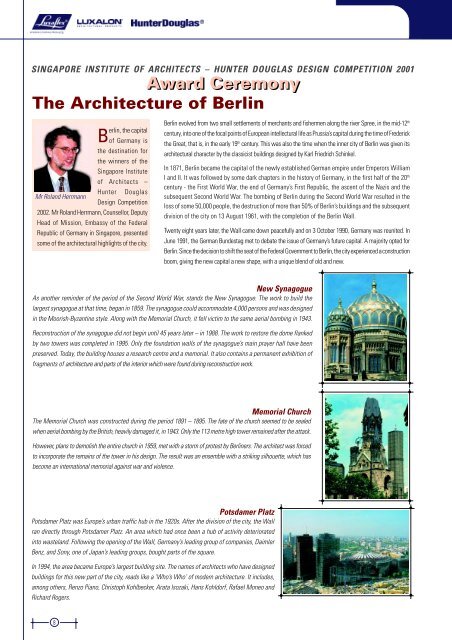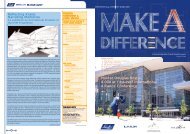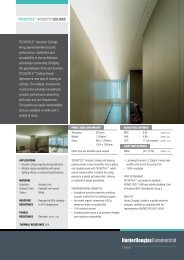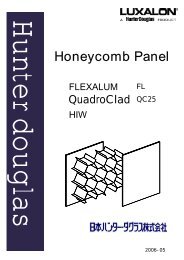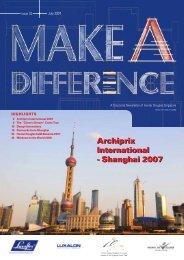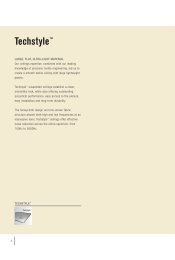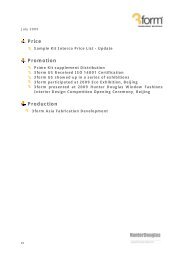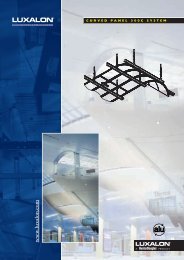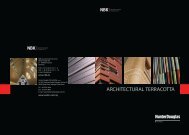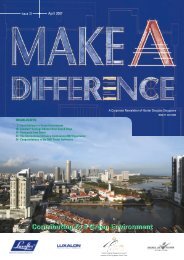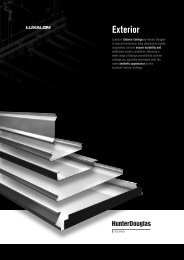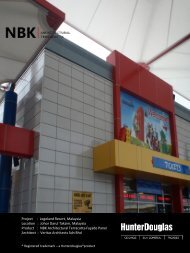Award Ceremony - ap.hunterdouglas....
Award Ceremony - ap.hunterdouglas....
Award Ceremony - ap.hunterdouglas....
Create successful ePaper yourself
Turn your PDF publications into a flip-book with our unique Google optimized e-Paper software.
SINGAPORE INSTITUTE OF ARCHITECTS – HUNTER DOUGLAS DESIGN COMPETITION 2001<strong>Award</strong> <strong>Ceremony</strong>The Architecture of BerlinBerlin, the c<strong>ap</strong>italof Germany isthe destination forthe winners of theSing<strong>ap</strong>ore Instituteof Architects –Hunter DouglasMr Roland HerrmannDesign Competition2002. Mr Roland Herrmann, Counsellor, DeputyHead of Mission, Embassy of the FederalRepublic of Germany in Sing<strong>ap</strong>ore, presentedsome of the architectural highlights of the city.Berlin evolved from two small settlements of merchants and fishermen along the river Spree, in the mid-12 thcentury, into one of the focal points of European intellectural life as Prussia’s c<strong>ap</strong>ital during the time of Frederickthe Great, that is, in the early 19 th century. This was also the time when the inner city of Berlin was given itsarchitectural character by the classicist buildings designed by Karl Friedrich Schinkel.In 1871, Berlin became the c<strong>ap</strong>ital of the newly established German empire under Emperors WilliamI and II. It was followed by some dark ch<strong>ap</strong>ters in the history of Germany, in the first half of the 20 thcentury - the First World War, the end of Germany’s First Republic, the ascent of the Nazis and thesubsequent Second World War. The bombing of Berlin during the Second World War resulted in theloss of some 50,000 people, the destruction of more than 50% of Berlin’s buildings and the subsequentdivision of the city on 13 August 1961, with the completion of the Berlin Wall.Twenty eight years later, the Wall came down peacefully and on 3 October 1990, Germany was reunited. InJune 1991, the German Bundestag met to debate the issue of Germany’s future c<strong>ap</strong>ital. A majority opted forBerlin. Since the decision to shift the seat of the Federal Government to Berlin, the city experienced a constructionboom, giving the new c<strong>ap</strong>ital a new sh<strong>ap</strong>e, with a unique blend of old and new.New SynagogueAs another reminder of the period of the Second World War, stands the New Synagogue. The work to build thelargest synagogue at that time, began in 1859. The synagogue could accommodate 4,000 persons and was designedin the Moorish-Byzantine style. Along with the Memorial Church, it fell victim to the same aerial bombing in 1943.Reconstruction of the synagogue did not begin until 45 years later – in 1988. The work to restore the dome flankedby two towers was completed in 1995. Only the foundation walls of the synagogue’s main prayer hall have beenpreserved. Today, the building houses a research centre and a memorial. It also contains a permanent exhibition offragments of architecture and parts of the interior which were found during reconstruction work.Memorial ChurchThe Memorial Church was constructed during the period 1891 – 1895. The fate of the church seemed to be sealedwhen aerial bombing by the British, heavily damaged it, in 1943. Only the 113 metre high tower remained after the attack.However, plans to demolish the entire church in 1959, met with a storm of protest by Berliners. The architect was forcedto incorporate the remains of the tower in his design. The result was an ensemble with a striking silhouette, which hasbecome an international memorial against war and violence.Potsdamer PlatzPotsdamer Platz was Europe’s urban traffic hub in the 1920s. After the division of the city, the Wallran directly through Potsdamer Platz. An area which had once been a hub of activity deterioratedinto wasteland. Following the opening of the Wall, Germany’s leading group of companies, DaimlerBenz, and Sony, one of J<strong>ap</strong>an’s leading groups, bought parts of the square.In 1994, the area became Europe’s largest building site. The names of architects who have designedbuildings for this new part of the city, reads like a ‘Who’s Who’ of modern architecture. It includes,among others, Renzo Piano, Christoph Kohlbecker, Arata Isozaki, Hans Kohldorf, Rafael Moneo andRichard Rogers.8


